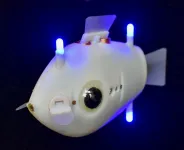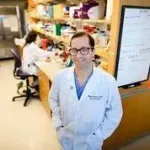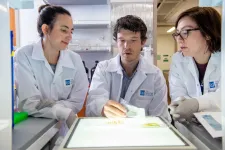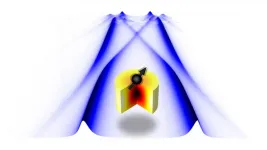(Press-News.org) Researchers from MBARI, the University of Hawai'i at Mānoa (UH Mānoa), and Woods Hole Oceanographic Institution, after years of development and testing, have successfully demonstrated that a fleet of autonomous robots can track and study a moving microbial community in an open-ocean eddy. The results of this research effort were recently published in Science Robotics.
Autonomous robotic fleets enable researchers to observe complex systems in ways that are otherwise impossible with purely ship-based or remote sensing techniques. In a time when the COVID-19 pandemic is reducing opportunities for researchers to go to sea, autonomous fleets offer an effective way to maintain a persistent presence in features of interest.
Oceanic microbes are essential players in the global climate system, producing roughly half of the world's oxygen, removing carbon dioxide, and forming the base of the marine food web. Open-ocean eddies can be over 100 kilometers (62 miles) across and last for months. Phytoplankton (a kind of microscopic algae) thrive when these eddies spin counterclockwise in the Northern Hemisphere and bring nutrient-rich water from the depths up toward the surface.
"The research challenge facing our interdisciplinary team of scientists and engineers was to figure out a way to enable a team of robots--communicating with us and each other--to track and sample the DCM," said Brett Hobson, a senior mechanical engineer at MBARI and a coauthor of this study. Researchers have struggled to study the DCM because at depths of more than 100 meters (328 feet), it can't be tracked with remote sensing from satellites. Moreover, the position of the DCM can shift more than 30 meters (98 feet) vertically in just a few hours. This variability in time and space requires technology that can embed itself in and around the DCM and follow the microbial community as it drifts in the ocean currents.
Ed DeLong and David Karl, oceanography professors in the UH Mānoa School of Ocean and Earth Science and Technology (SOEST) and co-authors of the study, have been researching these microbes for decades. DeLong noted that these teams of coordinated robotic vehicles offer a vital step toward autonomous and adaptive sampling of oceanographic features. "Open-ocean eddies can have a huge impact on microbes, but until now we haven't been able to observe them in this moving frame of reference," he explained.
During the Simons Collaboration on Ocean Processes and Ecology (SCOPE) Eddy Experiment in March and April 2018, researchers used satellite imaging to locate an eddy north of the Hawaiian Islands. They deployed a hi-tech team of three robots--two long-range autonomous underwater vehicles (LRAUVs) and one Wave Glider surface vehicle--from the Schmidt Ocean Institute's (SOI) research vessel Falkor.
The first LRAUV (named Aku) acted as the primary sampling robot. It was programmed to locate, track, and sample the DCM. Using an onboard 3rd-Generation Environmental Sample Processor (3G-ESP), Aku filtered and preserved seawater samples, allowing researchers to capture a series of snapshots of the organisms' genetic material and proteins.
The second LRAUV (named Opah) acoustically tracked Aku and spiraled vertically around it to collect crucial information about the environment surrounding the DCM. LRAUVs Aku and Opah carried a suite of sensors to measure temperature, salinity, depth, dissolved oxygen, chlorophyll concentrations, optical backscatter, and photosynthetically active radiation. Aku remained submerged for several days at a time sampling the DCM, while Opah surfaced every few hours to relay information via satellite back to scientists on the ship. A Wave Glider surface robot (named Mola) also tracked Aku with sonar and communicated with the science team aboard the Falkor.
"This work is really the fulfillment of a decades-long vision," said MBARI President and CEO Chris Scholin. Scholin has been engaged in this effort since he was an MBARI postdoctoral researcher seeking to develop autonomous sampling technology for marine systems. "Coordinating a robotic fleet to show how microbial communities react to changing conditions is a game-changer when it comes to oceanographic research."
The researchers determined that Aku accurately and consistently tracked the DCM over the course of its multi-day sampling missions. By tracking the temperature corresponding to the peak of chlorophyll (an indicator of phytoplankton) in the DCM, the LRAUV maintained its position within the DCM even as this biological feature moved as much as 36 meters (118 feet) vertically in four hours.
"Building an LRAUV with an integrated ESP that could track this feature was a milestone. Combining that sampling power with the agility of three different robots autonomously working together over the course of the experiment is a significant engineering and operations achievement," said Yanwu Zhang, a senior research engineer at MBARI and the lead author of this study.
Beyond the extraordinary engineering feat of organizing this robot ballet, the study also offers key takeaways related to how the biological community behaves inside a swirling eddy. RNA measurements reveal that as the eddy weakened into the second leg of the experiment, the phytoplankton biomass in the DCM decreased. "Much like our own team of researchers, each of the robots in the fleet is a specialist contributing to the experiment," said John Ryan, a senior research specialist at MBARI and a coauthor of the study. "This adaptive approach gives us a new perspective on the environmental processes going on inside and around this plankton community."
These robotic fleets are now also being used to monitor other key disturbances to ocean health like harmful algal blooms and oil spills. "Given the rapid changes our ocean is undergoing as a result of human activities such as climate change, pollution and overfishing, this technology has the potential to transform our ability to understand and predict ocean health," said Scholin.
INFORMATION:
This research is supported by the National Science Foundation, the Simons Foundation, the Gordon and Betty Moore Foundation, the Schmidt Ocean Institute, the David and Lucile Packard Foundation, and the State of Hawai'i.
Citation:
Yanwu Zhang, John P. Ryan, Brett W. Hobson, Brian Kieft, Anna Romano, Benedetto Barone, Christina M. Preston, Brent Roman, Ben-Yair Raanan, Douglas Pargett, Mathilde Dugenne, Angelicque E. White, Fernanda Henderikx Freitas, Steve Poulos, Samuel T. Wilson, Edward F. DeLong, David M. Karl, James M. Birch, James G. Bellingham, and Christopher A. Scholin (2021). A System of Coordinated Autonomous Robots for Lagrangian Studies of Microbial Communities in the Open-Ocean Deep Chlorophyll Maximum. Science Robotics (in press).
Rising temperatures could trigger Earth's terrestrial ecosystems to transition from carbon sinks to carbon sources in the next 20 to 30 years, according to data from the world's largest continuous carbon monitoring network. The researchers suggest that up to half of land ecosystems could reach this tipping point - when plants begin to release carbon into the atmosphere faster than they sequester it - by 2100 under a business-as-usual emissions scenario. However, biomes that store the most carbon, including rainforests and Taiga forests, may lose more than 45% of their ...
A keen sense of smell is a powerful ability shared by many organisms. However, it has proven difficult to replicate by artificial means. Researchers combined biological and engineered elements to create what is known as a biohybrid component. Their volatile organic compound sensor can effectively detect odors in gaseous form. They hope to refine the concept for use in medical diagnosis and the detection of hazardous materials.
Electronic devices such as cameras, microphones and pressure sensors enable machines to sense and quantify their environments optically, acoustically and physically. Our sense of smell however, despite being one of nature's most primal senses, has proven very difficult ...
Scientists from the Pacific Quantum Center of Far Eastern Federal University (FEFU) figured out how the AFV3-109 protein with slipknot structure folds and unfolds depending on temperature. The protein is typical for the viruses of the oldest single-celled organisms that can survive in the extreme conditions of underwater volcanic sources - archaea. The research outcome appears in PLOS ONE.
Using numerical methods and applying quantum field theory that is unique for the study of proteins, the FEFU scientists have probed into the folding topology (scheme) ...
DURHAM, N.C. - Most of the revenues extracted from use of the world's oceans is concentrated among 100 transnational corporations, which have been identified for the first time by researchers at Duke University and the Stockholm Resilience Centre at Stockholm University.
Dubbed the "Ocean 100," these "ocean economy" companies collectively generated $1.1 trillion in revenues in 2018, according to research published Wednesday in the journal Science Advances. If the group were a country, it would have the world's 16th-largest economy, roughly equivalent to the gross domestic product (GDP) of Mexico.
"Now that we know who some of the biggest beneficiaries from the ocean economy are, this can help improve transparency relating to sustainability and ocean ...
Schools of fish exhibit complex, synchronized behaviors that help them find food, migrate and evade predators. No one fish or team of fish coordinates these movements nor do fish communicate with each other about what to do next. Rather, these collective behaviors emerge from so-called implicit coordination -- individual fish making decisions based on what they see their neighbors doing.
This type of decentralized, autonomous self-organization and coordination has long fascinated scientists, especially in the field of robotics.
Now, a team of researchers at the Harvard John A. Paulson School of Engineering and ...
Philadelphia, January 13, 2021--Researchers at Children's Hospital of Philadelphia and the School of Engineering and Applied Science at the University of Pennsylvania have identified ionizable lipid nanoparticles that could be used to deliver mRNA as part of fetal therapy. The proof-of-concept study, published today in Science Advances, engineered and screened a number of lipid nanoparticle formulations for targeting mouse fetal organs and has laid the groundwork for testing potential therapies to treat genetic diseases before birth.
"This is an important first step in identifying nonviral mediated approaches for delivering cutting-edge therapies before birth," said co-senior author William H. Peranteau, MD, an attending surgeon in the Division of ...
PHILADELPHIA -- (Jan. 13, 2021) -- Scientists at The Wistar Institute discovered that Early Growth Response 1 (EGR1), a protein that turns on and off specific genes during blood cell development, inhibits expression of pro-inflammatory genes in macrophages. As part of their function to protect the body against pathogens, macrophages play a major role in initiation, maintenance, and resolution of inflammation. The discovery expands the understanding of how macrophages are set off and deactivated in the inflammatory process, which is critical in many normal and pathological conditions. These findings were published online in the journal Science Advances.
"By deepening the understanding of the role of EGR1, we ...
COLUMBUS, Ohio - While we wait for our turn to get vaccinated against SARS-CoV-2, we could - and probably should - use the time to make sure we bring our healthiest emotional and physical selves to the treatment, a new review of previous research suggests.
Ohio State University researchers reviewed 49 vaccine studies in humans dating back 30 years that document how stress, depression and poor health behaviors can negatively affect the body's immune response to vaccination, and how improving health factors can enhance that response.
The impaired immune responses tended to fall into three categories - interference with the ...
Skoltech researchers have found a way to use chemical sensors and computer vision to determine when grilled chicken is cooked just right. These tools can help restaurants monitor and automate cooking processes in their kitchens, and perhaps one day even end up in your 'smart' oven. The paper detailing this research results, supported by a Russian Science Foundation grant, was published in the journal Food Chemistry.
How do you tell that chicken breast on your grill is ready for your plate? You probably look at it closely and smell it to make sure it is done the way you like it. However, if you are a restaurant chef or head cook at a huge industrial ...
Scientists tame photon-magnon interaction.
Working with theorists in the University of Chicago's Pritzker School of Molecular Engineering, researchers in the U.S. Department of Energy's (DOE) Argonne National Laboratory have achieved a scientific control that is a first of its kind. They demonstrated a novel approach that allows real-time control of the interactions between microwave photons and magnons, potentially leading to advances in electronic devices and quantum signal processing.
Microwave photons are elementary particles forming the electromagnetic waves that we use for wireless communications. On the other hand, magnons are the elementary particles forming what scientists call "spin waves" -- wave-like disturbances in ...




